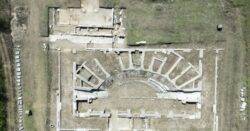Startling new finds have been made at an ancient Roman dig site which archaeologists once wrote off as ‘unpromising’.
Lacking any visible ruins, Interamna Lirenas, in central modern-day Italy, was initially thought to be a ‘backwater’ town that went into early decline at the turn of the first millenium.
But a 13-year study involving digs and radar surveys uncovered evidence suggesting it was still ‘thriving’ well into the 3rd century AD – when civil wars, barbarian invasions and political strife had started to plague the Roman Empire.
This means life for many ordinary Romans may not have gone downhill anywhere near as quickly as previously thought.
Cambridge professor Dr Alessandro Launaro, who led the research, said: ‘We started with a site so unpromising that no one had ever tried to excavate it – that’s very rare in Italy.
‘There was nothing on the surface, no visible evidence of buildings, just bits of broken pottery.
‘But what we discovered wasn’t a backwater, far from it. We found a thriving town adapting to every challenge thrown at it for 900 years.
‘We’re not saying that this town was special, it’s far more exciting than that. We think many other average Roman towns in Italy were just as resilient.
‘It’s just that archaeologists have only recently begun to apply the right techniques and approaches to see this.’
The site – around 130km from Rome – is now mostly crop fields, but Dr Launaro’s team found the remains of a roofed 1500-seater theatre, a market, a temple, a bath complex and a large warehouse suggesting the town was a river port.
They carried out a series of digs and used magnetic and ground-penetrating radar (GPR) across an area spanning 60 acres.
‘The fact that this town went for a roofed theatre, such a refined building, does not fit with a backwater in decline,’ Dr Launaro added.
‘This theatre was a major status symbol. It displayed the town’s wealth, power and ambition.
‘The assumed lack of a theatre here was taken as evidence of the town’s early decline.
‘At nearby Roman towns, archaeologists saw the remains of theatres sticking out of the ground.
‘The remains of Interamna Lirenas’s amazing theatre was there all along, just completely buried.’
The team previously discovered that Julius Caesar became a patron of Interamna Lirenas in 46BC.
Dr Launaro said the town ‘would have been valuable’ to the Roman dictator as it was ‘strategically located between a river and a major road, and it was a thriving node in the regional urban network’.
Founded in 312BC, it was eventually abandoned in the 6th century AD as Germanic invaders advanced deeper into modern-day Italy.
The study was published on Tuesday in the edited volume Roman Urbanism in Italy.





